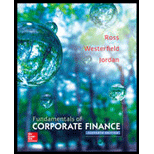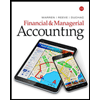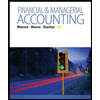
Fundamentals of Corporate Finance
11th Edition
ISBN: 9780077861704
Author: Stephen A. Ross Franco Modigliani Professor of Financial Economics Professor, Randolph W Westerfield Robert R. Dockson Deans Chair in Bus. Admin., Bradford D Jordan Professor
Publisher: McGraw-Hill Education
expand_more
expand_more
format_list_bulleted
Question
Chapter 18.6, Problem 18.6ACQ
Summary Introduction
To discuss: Whether FT Company has a projected deficit or sales
Introduction:
FT Company needs a fund on a short-term basis
Interest rate is 20% and payable on quarterly basis
Expert Solution & Answer
Want to see the full answer?
Check out a sample textbook solution
Students have asked these similar questions
What is the marketing communication budget plan for this types of campaign (not specific, can be general amount in peso):
• Television Commercial
• Radio
• In-store/banner/billboards
• Publication Materials for Facebook and Instagram
• Reels/TikTok Videos
• GIF
• Marathon
• Campus Caravan
• E-Vouchers
• Deals Offer
Considering a 60 million pesos budget for one year. Please cite references.
What is the amount of budget that could be provided using these advertisements?
(not specific, can be general amount in peso):
• Television Commercial
• Radio
• In-store/banner/billboards
• Publication Materials for Facebook and Instagram
• Reels/TikTok Videos
• GIF
• Marathon
• Campus Caravan
• E-Vouchers
• Deals Offer
Please cite references.
What is a blue-chip stock?
a) A stock with high volatilityb) A stock of a well-established, financially sound companyc) A newly launched IPO stockd) A stock with high dividends but low growth no ai
Chapter 18 Solutions
Fundamentals of Corporate Finance
Ch. 18.1 - What is the difference between net working capital...Ch. 18.1 - Prob. 18.1BCQCh. 18.1 - List five potential sources of cash.Ch. 18.1 - Prob. 18.1DCQCh. 18.2 - Prob. 18.2ACQCh. 18.2 - Prob. 18.2BCQCh. 18.2 - Prob. 18.2CCQCh. 18.3 - What keeps the real world from being an ideal one...Ch. 18.3 - What considerations determine the optimal size of...Ch. 18.3 - Prob. 18.3CCQ
Ch. 18.4 - Prob. 18.4ACQCh. 18.4 - Prob. 18.4BCQCh. 18.5 - Prob. 18.5ACQCh. 18.5 - Describe two types of secured loans.Ch. 18.6 - Prob. 18.6ACQCh. 18.6 - In Table 18.6, what would happen to Fun Toys...Ch. 18 - Prob. 18.1CTFCh. 18 - A firm has an operating cycle of 64 days and a...Ch. 18 - Prob. 18.4CTFCh. 18 - Prob. 18.5CTFCh. 18 - Operating Cycle [LO1] What are some of the...Ch. 18 - Prob. 2CRCTCh. 18 - Prob. 3CRCTCh. 18 - Cost of Current Assets [LO2] Loftis Manufacturing,...Ch. 18 - Operating and Cash Cycles [LO1] Is it possible for...Ch. 18 - Use the following information to answer Questions...Ch. 18 - Use the following information to answer Questions...Ch. 18 - Prob. 8CRCTCh. 18 - Use the following information to answer Questions...Ch. 18 - Use the following information to answer Questions...Ch. 18 - Changes in the Cash Account [LO4] Indicate the...Ch. 18 - Prob. 2QPCh. 18 - Changes in the Operating Cycle [LO1] Indicate the...Ch. 18 - Prob. 4QPCh. 18 - Calculating Cash Collections [LO3] The Morning...Ch. 18 - Prob. 6QPCh. 18 - Prob. 7QPCh. 18 - Calculating Payments [LO3] Sedman, Corp., has...Ch. 18 - Calculating Payments [LO3] The Torrey Pine...Ch. 18 - Calculating Cash Collections [LO3] The following...Ch. 18 - Calculating the Cash Budget [LO3] Here are some...Ch. 18 - Prob. 12QPCh. 18 - Prob. 13QPCh. 18 - Prob. 14QPCh. 18 - Calculating the Cash Budget [LO3] Wildcat, Inc.,...Ch. 18 - Prob. 16QPCh. 18 - Costs of Borrowing [LO3] In exchange for a 400...Ch. 18 - Prob. 18QPCh. 18 - Prob. 1MCh. 18 - Prob. 2MCh. 18 - Prob. 3M
Knowledge Booster
Similar questions
- What is a blue-chip stock? a) A stock with high volatilityb) A stock of a well-established, financially sound companyc) A newly launched IPO stockd) A stock with high dividends but low growth need help!arrow_forwardWhat is a blue-chip stock? a) A stock with high volatilityb) A stock of a well-established, financially sound companyc) A newly launched IPO stockd) A stock with high dividends but low growtharrow_forwardNeed help in this question !properly What does “liquidity” refer to in finance? a) The profitability of a companyb) The ease of converting assets into cashc) The stability of incomed) The level of debtarrow_forward
- I need help in this question! What does “liquidity” refer to in finance? a) The profitability of a companyb) The ease of converting assets into cashc) The stability of incomed) The level of debtarrow_forwardDont use chatgpt and give answer What does “liquidity” refer to in finance? a) The profitability of a companyb) The ease of converting assets into cashc) The stability of incomed) The level of debtarrow_forwardThe opportunity cost of holding cash is inversely related to the level of market interest rates. Question 9 options: True Falsearrow_forward
- Your firm deals strictly with four customers. The average amount that each customer pays per month along with the collection delay associated with each payment is shown below. Given this information, what is the amount of the average daily receipts? Assume that every month has 30 days. Customer Item Amount Delay A $8,500 5 days B $12,000 2 days C $16,000 3 days D $3,600 2 days Question 8 options: $8,448 $1,337 $3,342 $1,408 $10,025arrow_forwardWhich of the following is true regarding cash management? Question 7 options: The basic objective in cash management is to keep the investment in cash as low as possible while still operating efficiently and effectively. Effective cash management results in minimization of the total interest earnings involved with holding cash. A cost of holding cash is the liquidity it gives the firm. A firm should decrease its cash holdings as long as the NPV of doing so is negative. A cost of holding cash is the interest income earned on the outstanding cash balance.arrow_forwardLow default risk is a characteristic of money market securities. Question 6 options: True Falsearrow_forward
- Jeep Corp. held large sums of cash during the mid-1990s primarily because it would need a large amount of cash in the event of a recession. This is a[n] _____ for holding cash. Question 5 options: Adjustment motive. Compensating balances motive. Speculative motive. Transactions motive. Precautionary motive.arrow_forwardWith respect to the workings of a lockbox system, the cheque clearing process begins before the company even knows the payments have been received. Question 4 options: True Falsearrow_forwardYou are considering implementing a lockbox system for your firm. The system is expected to reduce the collection time by 1.5 days. On an average day, your firm receives 250 checks with an average value of $400 each. The daily interest rate on Treasury bills is .02%. What is the anticipated amount of the daily savings if this system is implemented? Question 3 options: $30 $25 $15 $20 $10arrow_forward
arrow_back_ios
SEE MORE QUESTIONS
arrow_forward_ios
Recommended textbooks for you
 Financial & Managerial AccountingAccountingISBN:9781337119207Author:Carl Warren, James M. Reeve, Jonathan DuchacPublisher:Cengage Learning
Financial & Managerial AccountingAccountingISBN:9781337119207Author:Carl Warren, James M. Reeve, Jonathan DuchacPublisher:Cengage Learning Financial & Managerial AccountingAccountingISBN:9781285866307Author:Carl Warren, James M. Reeve, Jonathan DuchacPublisher:Cengage Learning
Financial & Managerial AccountingAccountingISBN:9781285866307Author:Carl Warren, James M. Reeve, Jonathan DuchacPublisher:Cengage Learning- Century 21 Accounting Multicolumn JournalAccountingISBN:9781337679503Author:GilbertsonPublisher:CengagePrinciples of Accounting Volume 2AccountingISBN:9781947172609Author:OpenStaxPublisher:OpenStax College
 Intermediate Financial Management (MindTap Course...FinanceISBN:9781337395083Author:Eugene F. Brigham, Phillip R. DavesPublisher:Cengage Learning
Intermediate Financial Management (MindTap Course...FinanceISBN:9781337395083Author:Eugene F. Brigham, Phillip R. DavesPublisher:Cengage Learning


Financial & Managerial Accounting
Accounting
ISBN:9781337119207
Author:Carl Warren, James M. Reeve, Jonathan Duchac
Publisher:Cengage Learning

Financial & Managerial Accounting
Accounting
ISBN:9781285866307
Author:Carl Warren, James M. Reeve, Jonathan Duchac
Publisher:Cengage Learning

Century 21 Accounting Multicolumn Journal
Accounting
ISBN:9781337679503
Author:Gilbertson
Publisher:Cengage

Principles of Accounting Volume 2
Accounting
ISBN:9781947172609
Author:OpenStax
Publisher:OpenStax College

Intermediate Financial Management (MindTap Course...
Finance
ISBN:9781337395083
Author:Eugene F. Brigham, Phillip R. Daves
Publisher:Cengage Learning